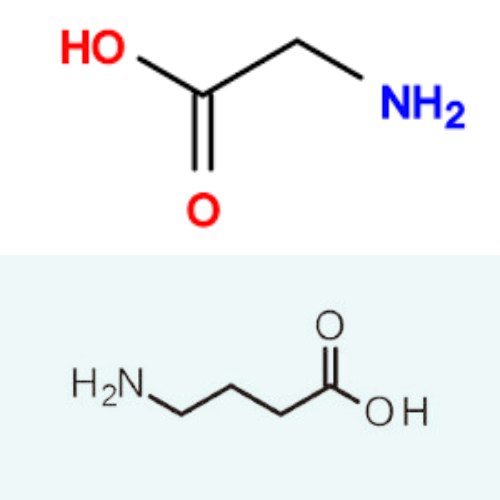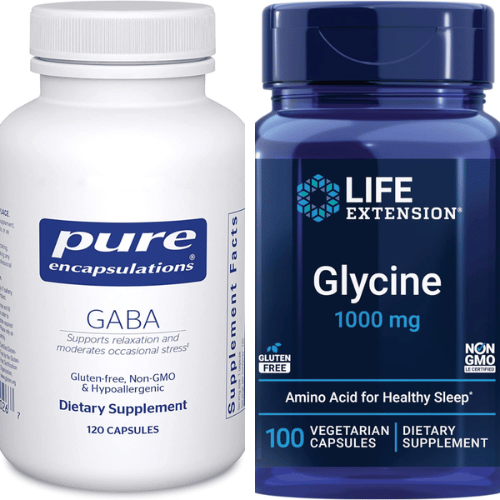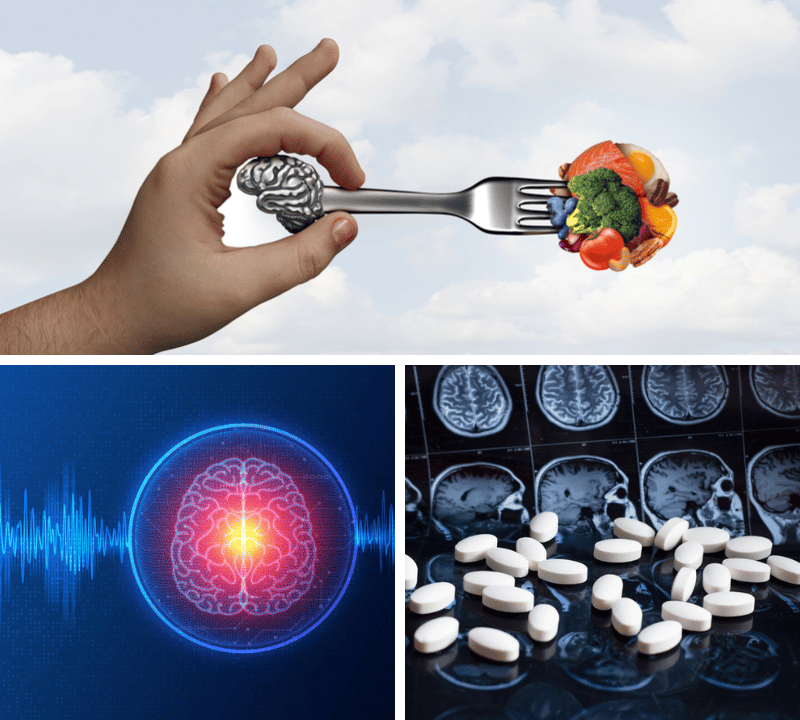Picture a chaotic city at rush hour—honking horns, bustling crowds, and blaring sirens. That could be your brain—without the harmonizing effects of essential amino acids like GABA and Glycine. Have you ever wondered what keeps our minds from spiraling into this chaos?
It's a battle of balance in our central nervous system. GABA and Glycine are guardians of this equilibrium, ensuring our brains aren't overwhelmed. These mighty amino acids control the delicate dance between excitement and calm within our minds.
But which of these neurotransmitters holds the valid key to optimal brain function? Uncover the intriguing mysteries of GABA and Glycine, from their distinct roles and interactions to their therapeutic prowess and profound health benefits.
Dive into this exploration, unlock the answer to the ultimate question, and address the question: which is better, GABA or glycine? Your brain’s well-being could hinge on this understanding. Read on!
Key Takeaways
- GABA and Glycine are essential inhibitory neurotransmitters that regulate neuronal excitation in the central nervous system.
- Both have a variety of health benefits, but excessive supplementation may cause side effects and interact with certain medications.
- Research has enabled the development of therapeutic applications for treating neurological and psychiatric disorders, improving sleep quality, and reducing anxiety.
Understanding GABA and Glycine

In the bustling metropolis that is our brain, GABA (γ-aminobutyric acid) and glycine serve as the traffic cops, diligently maintaining order and preventing chaos. These inhibitory amino acid neurotransmitters are integral to the central nervous system, sustaining the delicate balance between excitation and inhibition. GABA and glycine control neuronal excitability and are present in inhibitory synapses across the brain and spinal cord.
GABA: The Inhibitory Neurotransmitter
GABA is the primary inhibitory neurotransmitter in the brain and is synthesized from the excitatory neurotransmitter glutamate. GABA, like a skilled conductor, orchestrates the delicate balance of neuronal activity, helping to reduce excessive stimulation and promote a calming effect. This regulation of neuronal excitability is achieved through the action of the enzyme glutamic acid decarboxylase (GAD), which converts glutamate into GABA.
GABA signaling is terminated through a process of reuptake, during which the neurotransmitter is absorbed back into the presynaptic neuron and adjacent glial cells. Once reabsorbed, GABA is broken down by two enzymes. These are GABA transaminase and succinic semialdehyde dehydrogenase, which act as mitochondrial enzymes. This breakdown results in succinate production, which is then metabolized in the tricarboxylic acid cycle to facilitate cellular ATP and GABA synthesis.
The calming influence of GABA can be harnessed for therapeutic purposes. GABA receptor ligands, such as benzodiazepines, have been employed as:
- Antiepileptic medications
- Anticonvulsant medications
- Anxiolytic medications
- Hypnotic medications
These drugs act on GABA receptors to enhance the inhibitory effects of the neurotransmitter, providing relief from anxiety, insomnia, and epilepsy.
Glycine: Another Inhibitory Amino Acid
Glycine, another inhibitory neurotransmitter, predominantly resides in the spinal cord and brainstem. It plays a vital role in motor control and sensory processing, helping to coordinate muscle movement and transmit signals from our senses to our brains. Glycine’s inhibitory effects stem from its ability to bind to glycine receptors, which are ligand-gated ion channels that open upon binding to the neurotransmitter.
Although glycine is generally overshadowed by its more prominent counterpart, GABA, it remains an influential contributor to inhibitory neurotransmission. Glycine signaling is terminated through reuptake by transporters and conversion to serine. The reuptake process rapidly absorbs glycine into the presynaptic terminal or surrounding glial cells, ensuring the neurotransmitter’s signaling is effectively controlled.
Comparing GABA and Glycine Receptors
While GABA and glycine receptors share the goal of maintaining inhibitory neurotransmission, they differ in structure and function. GABA receptors comprise two α, two β, and one γ subunit, while glycine receptors consist of two α and three β subunits. This structural disparity results in distinct functional outcomes, with GABA receptors generating a channel pore and glycine receptors not.
Despite these differences, GABA and glycine receptors are united in their crucial role in inhibitory neurotransmission. The binding of GABA or glycine to their respective ionotropic receptors results in inhibition, an essential process in preserving the balance between excitation and inhibition in the central nervous system.
Ionotropic Receptors
Ionotropic receptors, including ionotropic glutamate receptors, are the rapid responders of the neurotransmitter world. These ligand-gated ion channels mediate fast synaptic transmission and are employed by both GABA-A and glycine receptors. Upon binding to specific neurotransmitters, ionotropic receptors quickly open, allowing ions to flow across the cell membrane and play a key role in synaptic communication in the brain.
GABA-A receptors, an ionotropic receptor, function as ligand-gated chloride channels. Their activation by GABA enables chloride ion passage into the cell, leading to membrane hyperpolarization and subsequent neuronal activity inhibition. This suppression of neuronal excitability is vital for adequately functioning the central nervous system and maintaining inhibitory neurotransmission, which also involves other receptors such as glutamate and NMDA receptors.
Belonging to the Cys-loop superfamily of ligand-gated ion channels, glycine receptors can be either homo- or heteropentameric in structure. Comprising an extracellular domain (ECD) and a transmembrane domain (TMD), their activation by glycine culminates in inhibitory effects on neuronal activity.
Metabotropic Receptors
Metabotropic receptors, such as metabotropic glutamate receptors, take a more leisurely approach to neurotransmission. These G-protein-coupled receptors mediate slower, modulatory effects, such as those produced by GABA-B receptors. Unlike ionotropic receptors, metabotropic receptors are not channel-linked and do not allow a direct flow of ions across the cell membrane. Instead, they activate intracellular signaling pathways through G-proteins, resulting in more prolonged and modulatory effects on neuronal activity.
GABA-B receptors, heterodimeric G protein-coupled inhibitory receptors, enable slow and prolonged signals in the central nervous system (CNS). They manage numerous functions, including neurotransmitter release, neuronal excitability, and synaptic plasticity. GABA-B receptors are mainly localized to neurons within the CNS and can be identified both presynaptically and postsynaptically. They are coupled to voltage-dependent ion channels and can modulate the activity of these channels, resulting in inhibitory effects on neuronal activity.
The activation of GABA-B receptors produces slower, modulatory effects by activating inhibitory Gi/Go proteins and inhibiting neurotransmitter release. This elicits a prolonged synaptic inhibition, thereby contributing to the modulatory effects of GABAB receptor activation.
Termination of GABA and Glycine Signaling
The conclusion of GABA and glycine signaling resembles the dimming of stage lights post-performance. Both neurotransmitters cease signaling through reuptake into the presynaptic terminal and packaging into synaptic vesicles or transportation into glial cells for disintegration.
This process ensures that the inhibitory effects of GABA and glycine are precisely controlled, maintaining the delicate balance between excitation and inhibition in the nervous system.
GABA Termination
GABA’s calming effect is temporary. After its release into the synaptic cleft and binding to its receptors, GABA is quickly reabsorbed into the presynaptic neuron through reuptake transporters like GAT1 (gamma-aminobutyric acid transporter 1) and other GABA transporter family members, including excitatory amino acid transporters. This rapid reuptake terminates GABA signaling and preserves the equilibrium of neurotransmitters in the synaptic cleft.
Once reabsorbed, GABA is broken down by two enzymes. These enzymes are called GABA transaminase and succinic semialdehyde dehydrogenase and are located in the mitochondria. This breakdown produces succinate, which is then metabolized in the tricarboxylic acid cycle to facilitate cellular ATP synthesis. This process ensures that GABA’s inhibitory effects are efficiently controlled and that the neurotransmitter is recycled for future use.
Glycine Termination
Similar to GABA, glycine’s inhibitory effects are limited. Following its release and binding to glycine receptors, the neurotransmitter is rapidly reabsorbed into the presynaptic terminal or adjacent glial cells via glycine transporters, such as GlyT1 and GlyT2. This reuptake process effectively terminates glycine signaling and maintains the balance between excitation and inhibition in the nervous system.
Once reabsorbed, glycine is converted to serine through the action of the enzyme serine hydroxymethyltransferase. While this conversion does not directly contribute to the termination of glycine signaling, it is an essential part of the neurotransmitter’s metabolic pathway.
In essence, the cessation of glycine signaling happens through reuptake by transporters and conversion to serine, thereby precisely controlling glycine’s inhibitory effects.
Benefits and Drawbacks of GABA and Glycine
The yin and yang of GABA and glycine offer a range of health benefits, as well as potential side effects and limitations. Both neurotransmitters have been associated with reducing anxiety, promoting sleep, and supporting cognitive function.
Nonetheless, over-supplementing either GABA or glycine might lead to undesired side effects or interfere with certain medications.
Health Benefits
GABA and glycine’s calming effects extend beyond the realm of neurotransmission, offering a variety of health benefits. GABA, for example, has been shown to help reduce anxiety, improve sleep quality, and support cognitive function. These benefits stem from GABA’s ability to bind to its receptors in the brain, producing a calming effect and helping to alleviate feelings of anxiety.
Glycine boasts an array of health benefits that include:
- Muscle growth
- Joint repair
- Inflammation reduction
- Liver protection from alcohol-induced damage
- Sleep quality enhancement
- Serotonin production stimulation
- Promotion of growth and well-being in humans and animals
These benefits are attributed to glycine’s role as an amino acid and its involvement in various metabolic processes.

While GABA and Glycine's health benefits are compelling, sourcing these amino acids from quality supplements is crucial to harness their full potential. Delving into the myriad of products available can be overwhelming. That's why I've done the homework for you. If you're curious about which brands and formulations genuinely shine in the market, I've meticulously reviewed and compiled the top five supplements for GABA and Glycine. These aren’t just supplements; they're top-tier choices from leading nutraceutical companies prioritizing quality and efficacy. These articles are indispensable guides for those seeking the best for their health. Curious? Check out my comprehensive reviews here for GABA and for Glycine. Your well-being deserves the best, and these articles aim to guide you right to it!
Side Effects and Limitations
While generally considered safe, excessive GABA or glycine supplementation may cause side effects or interact with certain medications. For instance, high intake of GABA has been associated with side effects such as:
- sore throat
- minor burning in the throat
- intermittent shortness of breath
- moderate drop in blood pressure
- tingling sensation
- upset stomach
- headache
- sleepiness
- muscle weakness
- gastric distress
- nausea
- diminished appetite
- constipation
- drowsiness
Similarly, glycine supplementation may cause the following side effects:
- Stomach upset
- Diarrhea
- Nausea
- Drowsiness
- Muscle cramps
- Dehydration
- Transient water retention in the early stages of supplementation
Glycine is generally well-tolerated, but high amounts of glycine may cause gastrointestinal symptoms such as abdominal pain.
Additionally, certain medications, such as antihypertensive drugs, benzodiazepines, and anticonvulsant drugs, may interact with GABA, while clozapine (Clozaril) may interact with glycine. So, always check with your healthcare professional before starting these or any other supplement for the first time.
Applications of GABA and Glycine in Therapeutics
The therapeutic potential of GABA and glycine is vast, with applications ranging from treating neurological and psychiatric disorders to enhancing sleep quality and reducing anxiety. As research continues to uncover the intricate mechanisms underlying GABA and glycine signaling, novel therapeutic approaches may emerge, offering new avenues for treating various conditions.
GABA-based Therapies
GABA-based therapies have been used to treat various psychiatric disorders, including anxiety, insomnia, and epilepsy. GABA receptor ligands, such as benzodiazepines, have been used to treat these conditions by enhancing the inhibitory effects of GABA, providing relief from anxiety, and promoting sleep. Benzodiazepines, such as diazepam and alprazolam, and medications with GABAergic properties, including pregabalin and gabapentin, act on GABA receptors to diminish anxiety symptoms.
GABA-based medications have a pivotal role in managing epilepsy. They:
- Enhance inhibitory neurotransmission
- Increase inhibitory neurotransmitter tone
- Target GABAA receptors to restore the balance between excitation and inhibition in the brain
This, in turn, reduces the frequency and intensity of seizures, providing relief for those affected by epilepsy.
Glycine-based Therapies
Glycine-based therapies show potential in treating a range of neurological disorders, such as epilepsy, Huntington’s disease, Parkinson’s disease, and Alzheimer’s disease. These therapies can regulate muscle tone, improve motor control, and provide therapeutic benefits for complex motor disorders by modulating glycine receptors. In addition, glycine-based therapies have been shown to have potential in treating pain conditions.
Research has also explored the potential of glycine receptor modulators in enhancing the efficacy of certain antipsychotic medications. It has been demonstrated that glycine can potentiate NMDA receptor-mediated neurotransmission and improve the treatment of neuroleptic-resistant negative symptoms in schizophrenia. Glycine transport -1 inhibitors have also shown procognitive and antipsychotic efficacy when used in combination with antipsychotics for the treatment of schizophrenia. However, further research is needed to fully understand the potential of glycine-based therapies in treating various neurological and psychiatric disorders.
Interactions Between GABA and Glycine Systems
The intricate interaction between GABA and glycine systems is essential for proper neuronal function. These neurotransmitters work in tandem to balance excitation and inhibition in the nervous system. When this balance is disrupted, it may contribute to the development of various neurological disorders.
Synergistic Effects
GABA and glycine can work together to enhance the inhibitory effects of both neurotransmitters. This synergy results in amplified inhibition of neuronal activity, helping to maintain the balance between excitation and inhibition in the central auditory system. This synergistic relationship between GABA and glycine is also evident in the strong interaction between the GABA(A) receptor and the glycine receptor.
Additionally, GABA and glycine can shunt excitatory postsynaptic potentials (EPSPs), reducing their amplitude and contributing to overall inhibition in the central auditory system. The cooperative action between GABA and glycine systems guarantees the preservation of the delicate balance between excitation and inhibition in the nervous system.
Competition and Balance
The equilibrium between GABA and glycine signaling is a cornerstone of proper neuronal function. Disruptions in this balance can lead to imbalances in inhibitory neurotransmission and contribute to neurological disorders. Some examples of these disorders include:
- Autism spectrum disorders
- Schizophrenia
- Epilepsy
- Alzheimer’s disease
Glycinergic signaling abnormalities can result in motor disorders such as hyperekplexia and hypertonia, while altered GABAergic neurotransmission has been associated with behavioral disorders, pain, and sleep disorders. Deviations from the ideal balance between excitation and inhibition can have significant consequences for the nervous system, highlighting the importance of maintaining the equilibrium between GABA and glycine signaling.
Let's Wrap Up This Amazing Journey Into These Magical Molecules!
While this article might tread a more technical path than most, grasping the intricate dance these two amino acids perform within our neurological system is essential. GABA and glycine, often overshadowed in the health dialogue, are the silent guardians of our central nervous system. They work incessantly to strike that crucial balance between stimulation and calm. Their impressive résumé spans from reducing anxiety, bolstering sleep, and sharpening cognition to promising therapeutic potentials for neurological and psychiatric anomalies.
Venturing deeper into the labyrinth of these inhibitory amino acids, our respect for their significance in our nervous framework and their overarching influence on our health only amplifies. Armed with insights about GABA and glycine's collaborative powers and the equilibrium of their signaling, we're not just learning – we're charting the roadmap for a holistically healthier, harmonized future. While the technical nuances can seem daunting, every tidbit you glean from this article might just prove invaluable when charting your supplementation journey. Your well-being is worth the deep dive!
Frequently Asked Questions
Can I take GABA and glycine?
Yes, you can take GABA and glycine, as they have potential health benefits. GABA can help reduce anxiety and stress, while glycine may support healthy digestion and skin.
What is the difference between GABA and glycine receptors?
Glycine helps to form creatine and collagen and plays a role in helping you sleep, while GABA acts as a neurotransmitter, balancing out the nervous system's activity. Glycine is more localized in the central nervous system than GABA, with about half of the inhibitory synapses in the spinal cord using it, compared to most other inhibitory synapses that use GABA.
What is the downside of taking GABA?
GABA supplements can interact with certain medications and may cause unwanted side effects such as upset stomach, headache, and sleepiness. People with existing conditions or those taking medications should talk to a healthcare provider before taking GABA supplements.
What is the relationship between GABA and glycine?
Glycine and GABA are the major inhibitory neurotransmitters in the CNS, targeting respective receptors belonging to the Cys-loop superfamily of pentameric ligand-gated ion channels (pLGICs).
How do GABA and glycine help maintain the balance between excitation and inhibition in the nervous system?
GABA and glycine act as inhibitory neurotransmitters, reducing neuronal excitability and thus helping to maintain the balance between excitation and inhibition in the nervous system.
Thanks for taking this journey with us to explore GABA versus Glycine benefits. And don't forget to check out our review articles on these two excellent supplements as well - they contain significant information to add to your library of knowledge!
Also, please return soon to check out our next review of another incredible supplement – we’re always looking out for YOU!
*We are not qualified medical advisors. The content here is only based on our personal opinions and should NOT be used as a substitute for a healthcare professional's advice!











Member discussion